Ever notice how your meetings always turn into debates about which department’s numbers are “correct”? Sales insist customer acquisition is up, marketing claims lead quality has never been better, yet finance is scratching their heads over declining conversion rates. It’s the same business, but completely different lenses.
If this disconnect were just awkward, it would be almost bearable, though it’s expensive. While your teams’ insights are trapped in departmental bubbles, competitors with merged infrastructure don’t have to work with puzzle pieces from different boxes.
Data warehouse integration breaks down these walls by funneling all your scattered information into one authoritative source. No more version battles, no more guesswork – just clean, consistent data that everyone can trust and act on immediately.
Let’s explore how integration transforms chaotic records into your secret weapon for smarter, faster decisions.
Table of Contents
- What is Data Warehouse Integration?
- Data Warehouse Integration vs. Data Integration: What’s the Difference?
- Benefits of Data Warehouse Integration for Your Business
- How Data Warehouse Integration Works: The Core Processes
- Common Use Cases of Data Warehouse Integration Across Industries
- Overcoming Key Challenges in Data Warehouse Integration
- A Step-by-Step Guide to Implementing Data Warehouse Integration
- The Future of Data Warehouse Integration
- Conclusion
What is Data Warehouse Integration?
Businesses generate data like a bustling city generates traffic. Without proper coordination, this constant flow creates a digital gridlock that slows down everything.
Data warehouse integration (DWH integration) is the process of pulling together data from all your business systems and delivering it into one central hub.
It happens through three essential steps that transform your data chaos into order:

- Extraction kicks things off by collecting information from every corner of your business ecosystem – operational systems, cloud platforms, APIs, external databases, and even those stubborn legacy systems that refuse to retire.
- Transformation takes over next, cleaning up the mess and making sure everything speaks the same language. It standardizes formats, removes duplicates, fills in missing pieces, and ensures your sales data plays nicely with your marketing metrics.
- Loading wraps up the process by moving all that big, beautiful, and polished data into your warehouse, where it sits, ready to illuminate the lightbulbs above your head.
At the output, you’re a proud owner of a single source of truth who can’t remember the last time they heard “Which numbers are we using?”.
Data Warehouse Integration vs. Data Integration: What’s the Difference?
So far, we’ve been moving in a straight line, but here’s a little exit ramp where things get interesting and where many businesses trip up.
The terms “data integration” and “data warehouse integration” may sound like corporate cousins, but there are significant differences.
Data integration casts a wide net. It pulls together information from multiple sources to create consistency. Data warehouse integration has a more focused mission. It’s specifically about channeling integrated data into an all-in-one DWH where it can support serious analytics.
Here’s how they stack up against each other:
| Aspect | Data Integration | Data Warehouse Integration |
|---|---|---|
| Purpose | Unify data for consistency across systems | Populate a DWH for analytics and reporting |
| Scope | Broad: any target system or application | Narrow: specifically targets the DWH |
| Timing | Real-time or batch processing | Typically, scheduled batch processing |
| Data Storage | May or may not involve long-term storage | Always involves centralized, structured storage |
| Audience | Operations teams, IT, and business units | Analysts, executives, and strategy teams |
| Main Benefit | Operational efficiency and seamless workflows | Strategic analytics and historical insights |
| Data Types | Structured, semi-structured, unstructured | Primarily structured and optimized |
The beauty is that these two approaches often tag-team together. But here’s the key insight: not every integration project needs to end up in a warehouse.
Sometimes, you just need your systems to communicate better for day-to-day efficiency. Other times, you’re building that analytical fortress that will give you competitive intelligence for years to come.
Benefits of Data Warehouse Integration for Your Business
Now that we’ve covered what data warehouse integration is and how it differs from its broader colleague, let’s talk about why businesses are jumping on this bullet train faster than you can say “quarterly report.”
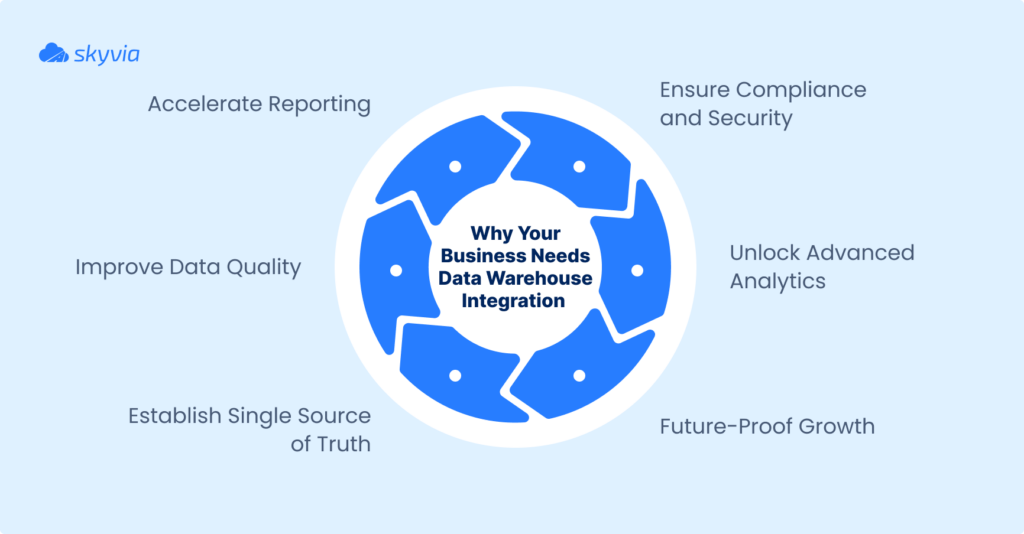
- Single Source of Truth
It puts an end to heated discussions in your boardroom by creating one source that everyone can trust. Additionally, when everyone uses the same data, there are fewer disagreements within teams, as their vision of future growth is based on similar or nearly identical insights.
- Strengthening Decision-Making Muscles
Businesses that use data warehouse integration report a 30% increase in decision-making efficiency. They learn that there’s a trend to use while the audience still finds it amusing. Companies identify opportunities while they are still ripe.
And their strategies are always based on full-scope insights. It’s the difference between navigating with a GPS versus trying to read a worn-out, old map, and there are no lights inside the car.
- Cleaning Up Your Data Act
Data warehouse integration gives collected data a spring cleaning, scrubbing away duplicates, filling in missing pieces, and standardizing formats, so everything plays nicely together.
- Reporting without Delays
Say goodbye to situations where you’re bargaining, denying, getting angry, and then accepting that you must wait for business analysts to pull custom reports or going through the same stages when trying to match spreadsheets from different systems.
Everything you need to gain insights, respond to market changes, and make adjustments before opportunities slip away is now in a centralized system.
- Better Operations at Lower Costs
Here’s where the bean counters get excited: data warehouse integration typically decreases storage costs by 20-30% while boosting processing speed by 30-50%. Mostly, this is possible because there are no duplicates that steal space, and manual processes are automated.
- Foundation for Future Growth
A business grows, and its data grows. Need to add new sources? Easy. Want to integrate acquisition data or expand into new markets? Your warehouse can handle it. This flexibility means that the system won’t hold you prisoner.
- Strengthening Team Collaboration
Transparency is a guarantee of consolidated efforts toward a similar goal. When marketing can see which products are selling, sales can understand which campaigns drive the best leads, and customer service can spot patterns that help prevent issues before they escalate.
- Unlocking Advanced Analytics Power
Synchronization between historical and real-time data opens the door to sophisticated analytics. Your data warehouse can become the foundation for AI and machine learning initiatives, providing a serious competitive edge.
Companies report up to 40% improvement in predictive analytics capabilities after implementing cloud-based data warehousing.
- Deeper Customer Intelligence
Website interactions, purchase history, support tickets, and social media engagement are united into a 360-degree view of your customers.
You’re standing on a summit (spoiler: you took an elevator), having a perfect perspective for running targeted marketing campaigns, improving retention strategies, and personalizing experiences that keep people coming back for more.
- Staying Compliant and Secure
Having all your data under one roof makes it easier to maintain audit trails, manage access permissions, and meet regulatory requirements without the nightmares of coordinating across countless systems.
How Data Warehouse Integration Works: The Core Processes
DWH integration is the backbone of unity, transformation, and meaningful insights.
The process involves several components, including ETL and ELT for data movement and transformation, as well as data modeling to optimize storage and querying. Let’s go step by step.
ETL: The Methodical Perfectionist
ETL (Extract, Transform, Load) has been the gold standard for decades, and for good reason. Here’s how it works:
- Extract – data gets pulled from every nook and cranny of your business ecosystem. Nothing escapes the extraction net.
- Transform – data gets the complete spa treatment. It’s cleaned, standardized, deduplicated, and molded into a consistent format.
- Load – data makes its grand entrance into the DWH.
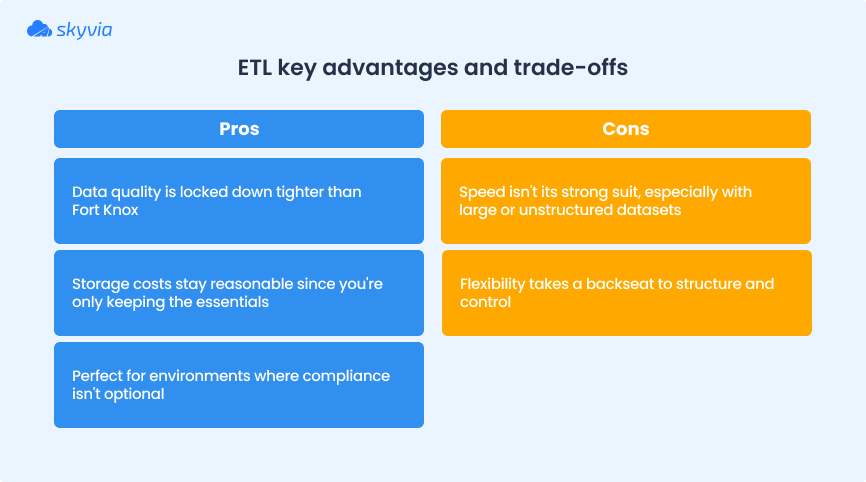
Go with ETL when:
- You need ironclad data quality and strict compliance.
- Complex transformation logic is non-negotiable.
- You’re working with on-premises systems that need to squeeze every drop of performance.
- Batch processing fits your operational rhythm.
ELT: The Innovator
ELT (Extract, Load, Transform) is the newer player with a “move fast and optimize later” philosophy. Its beauty lies in its adaptability. Need to slice your data differently for a new project? No problem.
The same raw input can be transformed in completely different ways, but you don’t have to worry about stepping on another team’s toes; pure workplace democracy in action.
The ELT approach flips the traditional script:
- Extract – similar to ETL, data is collected from all your source systems.
- Load comes immediately after, and things get interesting. Raw data gets loaded straight into the data warehouse.
- Transform happens last. The data gets its makeover inside the warehouse itself.
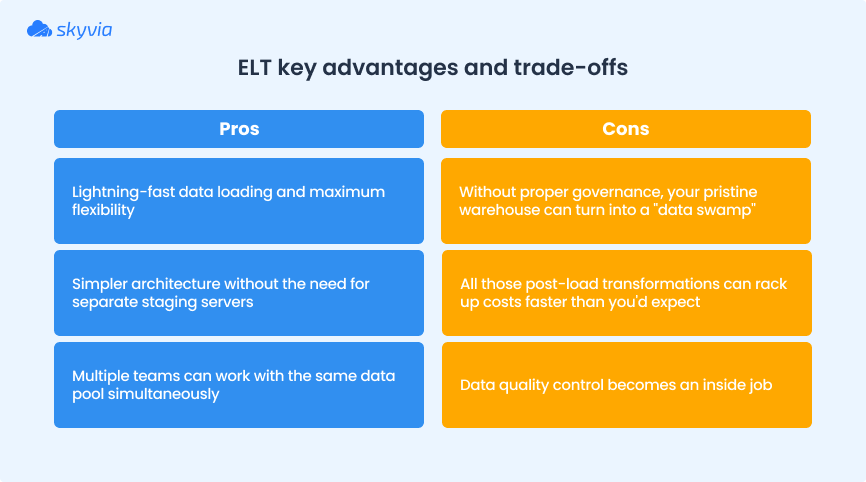
Choose ELT when:
- You’re riding the cloud wave with scalable infrastructure.
- Big data volumes are your reality.
- Flexibility and speed-to-insight are crucial.
- Multiple teams need to work with the same data differently.
Data Modeling
The data has found its new home, so it’s time to organize it in a way that makes sense. That is where you need data modeling.
It’s like being a data warehouse interior designer but with a little difference. Instead of choosing between wallpaper or couch styles, you’re deciding how to structure information for maximum impact.
- Star Schema
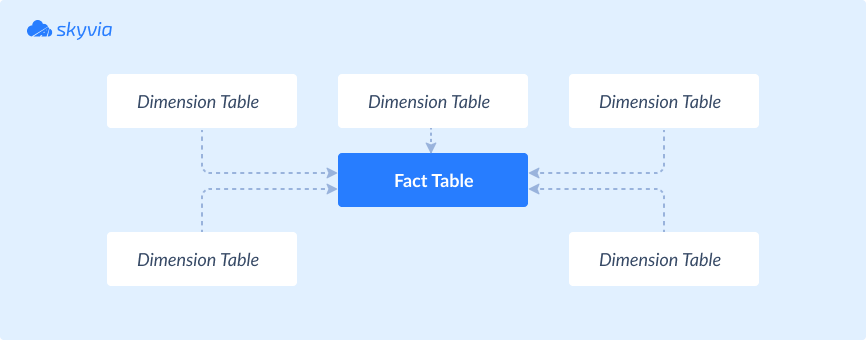
The star schema is clean, simple, and gets the job done without unnecessary complications – the minimalist’s dream come true. At the center sits your fact table, which stores all your transactional data, such as sales figures, website clicks, or customer interactions.
Customer, product, and time dimension tables surround it, each one denormalized and ready to deliver answers fast.
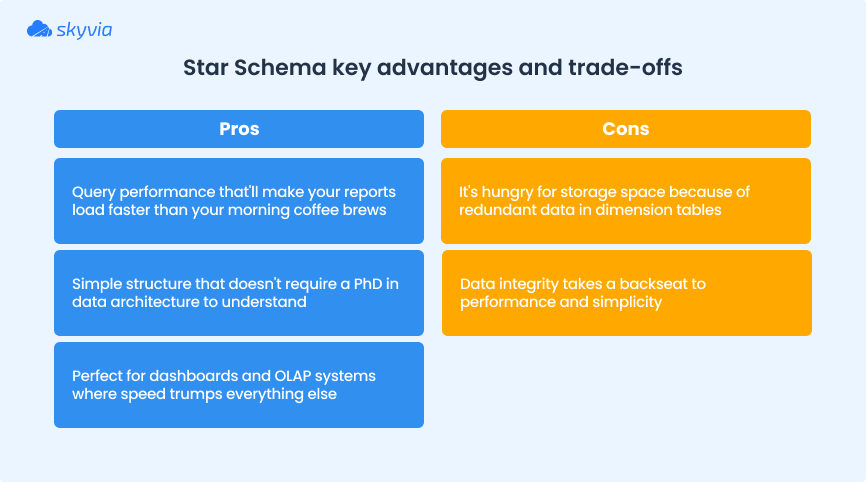
Pick the star schema when:
- Query speed is your top priority.
- Users need simple, intuitive data structures.
- You’re building dashboards and reporting systems.
- Storage costs aren’t a major concern.
- Snowflake Schema
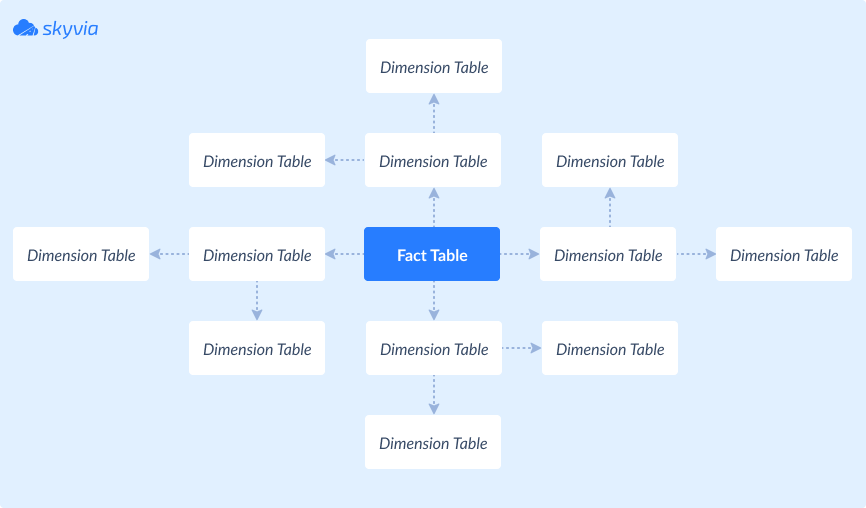
Instead of keeping everything in flat, wide dimension tables, Snowflake schema normalizes them into a web of interconnected tables.
Your customer dimension might split into separate tables for addresses, cities, states, and countries. It’s more complex, sure, but it’s also more storage-efficient and maintains rock-solid data integrity.
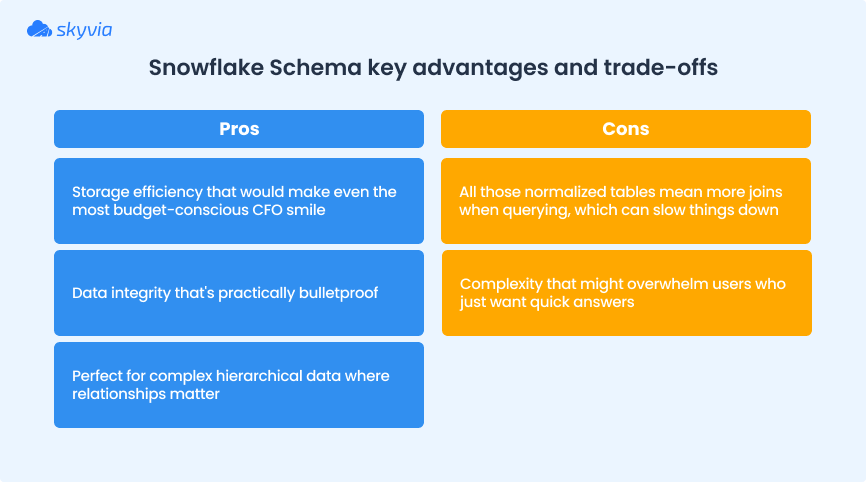
Opt for the snowflake schema when:
- Storage efficiency matters to your bottom line.
- Data integrity is critical.
- You’re dealing with complex hierarchical relationships.
- Long-term scalability is part of your strategic plan.
- Galaxy Schema
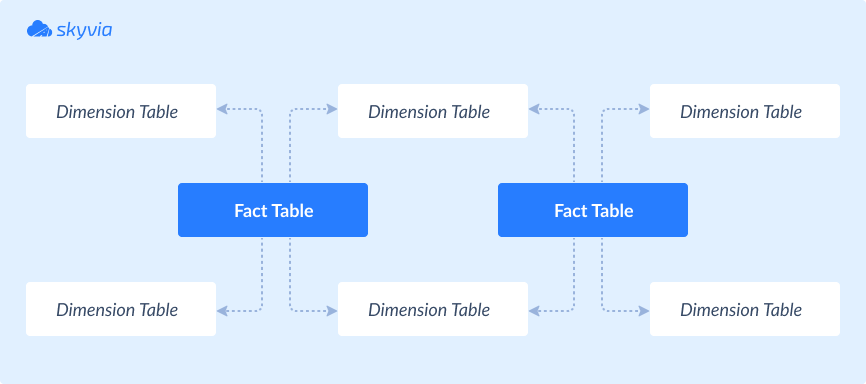
It’s the overachiever of the data warehouse world. Instead of having one central hub, you’ve got several interconnected business processes all sharing the same neighborhood.
Your sales data mingles with inventory figures, shipping records cozy up to customer interactions, and they all play nice together because they’re sharing the same tables.
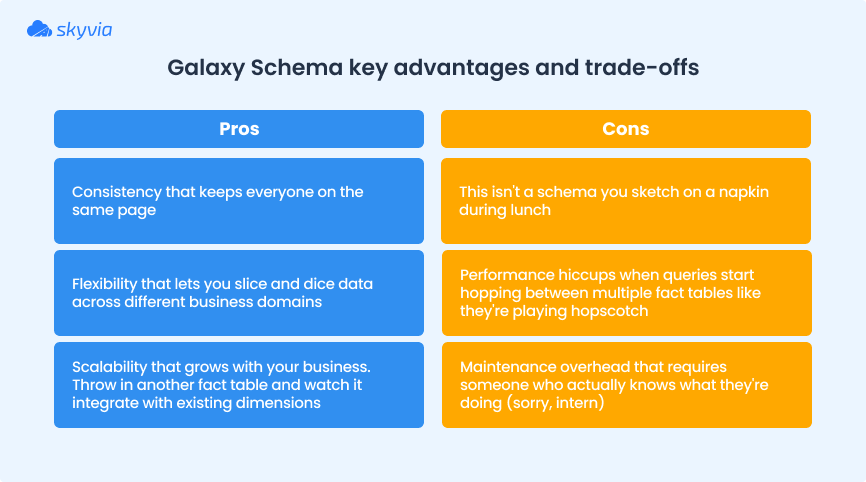
Where to use the Galaxy schema:
- When your organization is juggling multiple business processes, but they share common ground.
- For cross-functional reporting that needs to connect the dots between different departments.
- When data consistency and integrated analytics are make-or-break for business intelligence.
Pulling it together: Data modeling happens when ETL or ELT is done. Then, you will have to maintain the system, tend this garden, so it stays effective. You’re a groundskeeper, and updating, auditing, and fine-tuning are your primary responsibilities.
At the same time, business users and analysts can finally dig into the data, run queries, generate reports, and uncover insights that drive smart decisions.
Common Use Cases of Data Warehouse Integration Across Industries
Bringing all the data into one space isn’t just a fancy idea that sounds impressive in boardroom presentations; it does fancy things with your data.
Businesses from numerous industries already enjoy its effects. Let’s go over some examples:
- Retail & E-Commerce: The Customer Whisperers
Remember the great toilet paper shortage of 2020? Sure, COVID-19 caused that chaos, but it also revealed what happens when retailers fly blind. Integrated data warehouses help stores walk that fine line between overflow and empty shelves.
Feed in sales data, supplier intel, seasonal quirks, weather patterns, or a pandemic outburst, and voilà – you’ve got demand forecasting.
- Healthcare: Where Data Saves Lives
Every patient is a walking collection of data points, including medical history, lab results, imaging scans, prescription records, insurance information, and, increasingly, data from wearable devices.
Through the integration of data warehouses, physicians can draw patterns, foresee complications in recovery, and individualize their treatment in a manner that would have been viewed as science fiction only ten years ago.
Another excellent example of why data warehouse integration works in healthcare from the previous life: when COVID-19 struck, countries and regions that had already invested in systems of integrated health data were able to react quicker and more efficiently compared to those that continued to catch up using spreadsheets and manual reporting.
- Financial Services: The Money Protectors
The integrated data warehouses help banks maintain audit trails, produce compliance reports, and stay within the scope of anti-money laundering regulations. It’s similar to a highly effective filing cabinet, with no documents misplaced and all records ready to be printed out for any report that a regulator may request.
It also helps to keep customers devoted and active. Financial institutions can analyze spending patterns, life events, and economic behaviors to offer perfectly timed products and services.
When your bank offers you a mortgage pre-approval right after you’ve been browsing real estate websites, that’s integrated data warehouse intelligence at work.
- Manufacturing: The Efficiency Engine
Modern manufacturing facilities are essentially giant data-generating machines. IoT sensors monitor everything from temperature and vibration to production speed and quality metrics. Without integration, this data is just noise. With it, it becomes the foundation for predictive maintenance, quality control, and optimization.
Also, contemporary supply chains extend worldwide, with hundreds of suppliers and various types of transport included. Manufacturers gain real-time information on this web through integrated DWHs.
For example, when a supplier in China experiences a delay, an integrated system can instantly recalculate how this affects production schedules in Germany and propose alternative suppliers or changes to the production plans.
- Telecommunications: Connecting People
Telecom networks can be characterized as the most complex traffic management system in the world. Although the traffic on the road never stops, jams in one location can cause a million people to come to a standstill.
Integrated data warehouses assist companies in monitoring network performance, predicting capacity needs, and optimizing routing in real time.
When your phone company offers you a better plan right before you are thinking about switching, that’s integrated customer analytics working behind the scenes.
Regardless of what you are selling or offering, your data can only be as strong as your capacity to integrate it, analyze it, and act on it.
Overcoming Key Challenges in Data Warehouse Integration
Every organization faces a similar set of challenges, with some specific variations. The good news? None of them is necessarily a dead-end; they just need the right approach.
Let’s take a look at roadblocks that might be waiting for you down the road and, more importantly, how to navigate around them without scratching the vehicle.
1. Integration Complexity
Remember the biblical Tower of Babel? That’s the best illustration of what happens when proper planning doesn’t go before data from multiple systems integration.
Each source has its own format, structure, and quirks. The complexity multiplies when you realize that “customer ID” in your sales system might be called “client_reference” in your billing system and “user_key” in your support platform. What should be a simple mapping exercise turns into a detective story.
How do you push through this language barrier?
- Invest in ETL/ELT tools, such as Skyvia, which come with a comprehensive gallery of connectors. These tools are like skilled interpreters who speak dozens of languages fluently.
- Standardize as much as possible in your organization. Design standard models, naming, and formats that everyone can follow in their operations.
- Use middleware solutions when you encounter particularly stubborn compatibility issues. Sometimes even the translator needs a translator, and that’s perfectly okay.
2. Quality and Consistency
When your DWH is filled with duplicates, missing values, and inconsistent formats, your analytics is using a broken thermometer for diagnosis.
The gist of this is that data quality issues are sneaky. They don’t announce themselves. Instead, they come uninvited and quietly undermine your reports.
How do you make this work?
- Automate cleansing within the ETL/ELT pipeline. They intercept issues before they have an opportunity to turn into expensive headaches.
- Put in place firm governance policies based on clear roles and responsibilities. Appoint data stewards, ensuring everything is cataloged correctly and maintained.
- Use profiling tools, such as a fitness tracker, to continuously monitor your data health. They keep you informed about what’s working well and what needs attention.
- Create quality metrics that matter to your business because if you can’t measure something, you can’t manage it.
3. Scalability and Performance
The better your DWH performs, the more input gets poured into it, and more complicated queries are run. In a little time, you will require a larger table and additional chairs for this feast.
That is especially problematic when working with historical data that is continuously increasing and trying to provide a real-time understanding.
What’s the secret to beating this?
- Select cloud-based platforms that feature elastic scaling on demand.
- Implement smart data partitioning and indexing to optimize query performance.
- Regularly monitor and adjust your ETL/ELT processes whenever needed to improve efficiency.
- Use caching strategically for accessing records you need frequently. People get what they need faster, and overall efficiency improves.
4. Security and Compliance
Putting all your eggs in one basket is efficient. But if that basket contains sensitive customer information, the stakes couldn’t be higher. When one company’s data breach makes headlines, others in the industry wince.
Unless you’re a market giant with a product everyone can’t live without, such losses can destroy customer trust, trigger regulatory fines, and damage brand reputation in ways that take years to recover.
How do you navigate around?
- Use encryption for data both at rest and in transit to make it useless for everyone willing to steal it.
- Apply strict access controls with role-based permissions because not everyone needs access to everything.
- Use masking and anonymization for sensitive fields when possible.
- Ensure that there are thorough audit trails and lots of security tests. Intruders upgrade their skills, so you have to be at least one step ahead.
5. Cost and Resources Reality Check
Building and maintaining a DWH isn’t cheap, and you always have to be prepared that the costs may spiral out of control. What starts as a simple integration project can quickly become your own Cologne Cathedral.
The challenge is particularly painful for smaller organizations that need the benefits of data integration but can’t afford enterprise-level solutions and teams.
How do you make this work?
- Invest in platforms that support numerous scenarios and connections and have user-friendly interfaces. This way, you save money and time on the data stack and specialists. For example, with Skyvia, smaller businesses can achieve the desired integration without placing too much of a burden on their budgets.
- Automate routine tasks wherever possible to reduce ongoing labor costs. The standard loop frees space for important jobs.
- Use cloud infrastructure with pay-as-you-go pricing models. That lets you scale costs with usage rather than paying for peak capacity, while you may never reach this point.
A Step-by-Step Guide to Implementing Data Warehouse Integration
Now, let’s move from pure theory to theory with a bit of practical glitter, bringing all the data from various sources, transforming it into something meaningful, and storing it in a way that allows for seamless analysis whenever you need it. Here are some of the best practices for DWH integration:

- What are Business Objectives and Requirements?
Although many teams are willing to pursue DWH integration to shorten meetings and reduce their frequency, the process typically begins with discussions and planning. Engage all the key players: decision-makers, IT, and compliance teams.
The project is going to be grand, so it’s better to listen to everyone who will take part and everyone who will use it later. That’s much safer than changing something after you finish it.
This phase sets the direction for the whole integration process. Align on the shared goals:
- What data do you need?
- How will it be used later?
- What can be done when you need something else over time?
- What Data Sources Are There?
Once your goals are clear, check what sources you have and identify which ones you may need to add to your stack. It’s like setting up ingredients before cooking. Check the quality of the data you’ve already accumulated. Make sure there are no duplicates or missing values.
- Design Data Warehouse Architecture
Think of your DWH architecture as your workspace setup. Do you want everything in your home office (on-premises), rent space in a sleek co-working facility (cloud), or split between both locations (hybrid)? Once you choose, plan for development, testing, and production environments according to the type to avoid chaos.
- Select Integration Strategies and Tools
The job needs the right tools. Choose between ETL or ELT, depending on your needs. Also, CDC (Change Data Capture) is great for real-time updates. Of course, knowing what you need and actually getting it are two different challenges.
You could piece together different tools for each requirement, but the Frankestain monster you create will likely cause more problems than it solves. A platform that can support all of these and allow you to change directions and perspectives when needed is Skyvia. It’s a data integration solution with:
- Over 200 ready-to-use connectors (none of your sources will be left unattached).
- Intuitive, wizard-based interface (training for the team won’t take long, as there are no significant code-related pitfalls). NISO, an outsourced CFO company, could quit manual input and custom API development thanks to Skyvia’s no-code integration solutions.
- CDC support to guarantee real-time consistency and minimize manual labor.
- Automation and scheduling to run pipelines on autopilot. For example, TitanHQ used Skyvia to automate data integration from SugarCRM to Snowflake data warehouse, saving time and costs.
- Finally, a 14-day free trial with all the features available for a test drive (ensure you have all the answers within one platform before committing) and flexible pricing.
- Data Modeling and Schema Design
It’s time to define how records will be structured: a star schema, snowflake, or galaxy? Choose a schema where data relationships are logical and easy to navigate.
Also, don’t forget to leave some space for growth. Surely, your data might look better in one of the schema types, but will it stay this way if you start to develop rapidly?
- Implement Data Integration Pipelines
The warm-up is done; roll up your sleeves to build the ETL/ELT workflows and set up automation. Schedule tasks to run on time and ensure that data quality checks are part of the process.
After all, garbage in, garbage out, and you definitely don’t want your analytics serving up a data disaster when the stakes are high.
- Testing and Validation
Before rolling out to production, thoroughly test everything. Ensure data loads and transforms correctly, check system performance, and confirm compliance with security standards. You don’t want to find out something’s wrong after launch.
- Deployment and Training
Once the system is running, train your team (both business users and tech folks) on how to access and manage the warehouse. Depending on the tool you choose, the process can be brief and concise or resemble a training boot camp.
- Monitoring and Maintenance
Keep an eye on the system’s health, monitor its performance, and adjust it as necessary to scale with your business growth. It’s all about staying in fighting shape.
The Future of Data Warehouse Integration
Once, the data warehouse landscape resembled a static library where data went to gather dust. Now, it’s morphing into a lively, intelligent ecosystem. Impressive? Surely, but we’re just getting started.
- The Cloud Gold Rush: Sky’s the Limit
The cloud data warehouse market is set to explode from $36.31 billion in 2025 to a whopping $58.07 billion by 2034.
More and more organizations are ditching their on-premises hardware. Why? Because cloud platforms offer the kind of scalability that traditional systems can’t beat. Hybrid and multi-cloud deployments are becoming the norm.
Companies are storing their data with various cloud providers. This approach lets them cherry-pick the best features from each platform while keeping their legacy systems happy during the transition.
- AI and ML: The Dynamic Duo Taking Over
Artificial Intelligence and Machine Learning are not going anywhere anytime soon; they are here to stay and likely bring friends we haven’t heard about yet. They are turning what used to be a manual nightmare into an automated dream.
AI algorithms in ETL processes streamline data preparation, clean up messy datasets, and even predict which records you’ll need before you know you need them. Machine Learning models refine quality and automate sensitive data masking.
- Real-Time Integration: The Need for Speed
Real-time data warehousing has shifted from a “nice-to-have” luxury to a “must-have” necessity. Pipeline automation is reshaping the entire landscape. These smart systems reduce errors, speed up data ingestion, and enable continuous data flow orchestration that would make a symphony conductor proud.
DataOps principles are emerging as the new playbook, bringing software development practices to data management with impressive results.
- Data Fabric: The Ultimate Unifier
Multimodal data fabrics are quickly becoming the architectural approach. They unify fragmented records across warehouses, lakes, and streaming systems into a single, manageable environment.
It constantly captures metadata, understands dataset relationships, and automates integration tasks such as schema change detection and data flow orchestration. By 2026, around 60% of enterprises are expected to adopt the data fabric approach, and for good reason.
The DWH revolution is far from over; in fact, it’s only getting started. The future will belong to those who can turn chaos into a strategic advantage.
Conclusion
Data warehouse integration has been promoted from “nice-to-have” to “can’t-live-without-it.” When a business pulls together all those scattered pieces of information floating around the organization, it’s not just tidying up; it’s building the foundation for a serious competitive advantage.
Here’s what happens when you get your data act together:
- Decision-making is lightning-fast – rely on facts, not gut feelings.
- Teams finally start singing from the same hymn sheet – goodbye to those awkward “my data is better than yours” moments.
- Efficiency has never been higher – instead of comparing numbers, analyze insights.
Let your competitors struggle with spreadsheets and pray their reports are accurate while you do what matters in your industry. Skyvia’s no-code platform makes integration so smooth, you’ll wonder why you ever thought it was complicated.
So, why wait another day to get that data tamed? Start your 14-day free trial and experience the Skyvia difference!
F.A.Q. for Data Warehouse Integration
Is ETL the only way to perform data warehouse integration?
No, there’s more. ELT, CDC, data virtualization, and replication can also be used, depending on the specific needs, like real-time updates or large data volumes.
How does data warehouse integration improve data quality?
It cleans, transforms, and standardizes input, getting rid of duplicates, filling gaps, and ensuring consistency.
Can small businesses benefit from data warehouse integration?
Yes! Small businesses will also find integration useful for improving decision-making and efficiency. Tools like Skyvia make this possible even for small businesses.
What are the most popular data warehouse integration tools?
Popular tools include Skyvia, Talend, and Fivetran. These tools offer various capabilities, such as ETL/ELT, real-time syncing, and cloud support, catering to different business needs and integration scenarios.




